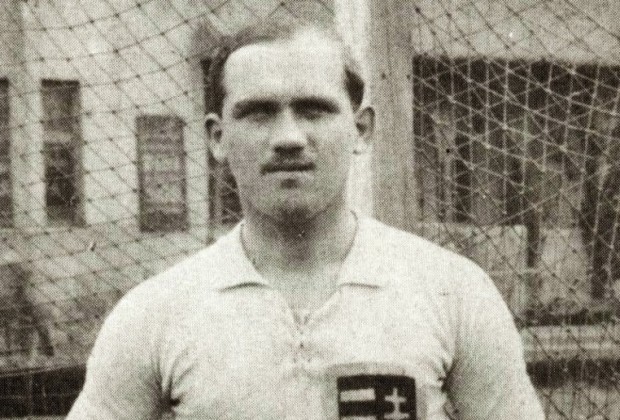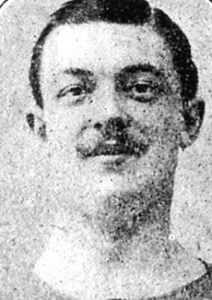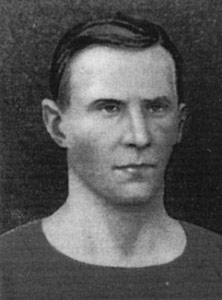CURIOUS FACTS ABOUT NATIONAL AND INTERNATIONAL PLAYERS (1909)
Picture : Imre Schlosser, the Hungarian Top Goal Scorer
Interesting and curious facts about full internationals and national players (1909)
————————————————————————————————————–by IFFHS—
1909
Frederick Beaconsfield Pentland was born in Wolverhampton on September 18, 1883, but found his football legs with Small Heath in nearby Birmingham. Just as the club was promoted to the first division in 1903, Pentland transferred to Blackburn Rovers, where he only was a reserve during the 1905/06 season before switching to Brentford. He then went on to play for Queen’s Park Rangers (1907/08) and Middlesbrough (1908-1912), also briefly for Haifax Town and Stoke FC. “Fred” Pentland was a quick and nimble outside right, clever with the ball and provided brilliant centre passes. In 1909 he played for England five times. During the 1913/14 season he went to work as a trainer in Germany, where he unjustly interned for four years after the outbreak of World War I. During the 1920/21 season he coached in France, and then in Spain until 1936. He died on March 16, 1962.
——
On the occasion of the FIFA Congress in Budapest,Hungary played three full “A” internationals at Millenáris pálya (29.5.-31.5.1909). They lost two matches to England (2:4 and 2:8) and drew one with Austria (1:1). The young Imre Schlosser and Dr. Gáspár Borbás were Hungary’s bright lights on the left wing. 19 year-old goalkeeper Ferenc Bihary-Büchelmayer was the only player to take part in all three matches.
——
Towards year-end 1908 the USFSA (France) rashly left FIFA and its place was taken by its national rival CFI. None of the clubs affiliated with it had any players with international experience, but these were the players which now had to be fielded at full “A” internationals since those who had previously been national players were with clubs affiliated with the USFSA and so no longer eligible for the national team. Thus France did not stand a chance and lost both their full “A” internationals in 1909, against Belgium (2:5) and the England amateurs (0:11).
——
On March 16, 1909, Germany played a full “A” international against the England amateur national team in Oxford. The sea had been rough while crossing from Dover the previous day, and some of the players still suffered from seasickness, which is likely to have contributed to Germany’s 0:9 defeat. One of these was left full-back Erich Massiniof FC Preussen (Berlin), who was born on September 13, 1889. He had not fully recovered, his performance was accordingly poor, and this would be his only full “A” international. He fell on July 26, 1915, while fighting in World War I.
——
George Hebdin(19.4.1889-26.3.1970) played his third full “A” international for Belgium, in Antwerp against the Netherlands (1:4) on March 21, 1909. It was not until after this match that the Belgian FA realised that the centre forward of Union St.-Gilloise only had British citizenship, and henceforth no longer considered him for full “A” internationals. However, a FIFA ruling in 1912 made his return to the national team possible. According to this ruling, a foreigner was eligible to play for the national team if he had lived in the country for ten years. Thus, from 1913 on, George Hebdin played for the “Diables Rouges” again, now as outside left. He played a total of 12 times for them, including the gold medal at the Olympic football tournament in 1920.
——
George Hebdin
Germany enjoyed their full international win in Karlsruhe on April 4, 1909 (1:0 Switzerland). Much of the credit for the victory goes to right full-back Dr. Otto Nicodemus. The sturdy and precise defender was born in the Biebrich district of Wiesbaden on June 21, 1886. He studied natural sciences and later became the head of a laboratory, but still played for Freiburger FC. He was also s one of Germany’s top philately experts. He died of a stroke on December 2, 1966.
——
On April 4, 1909, Germany adopted the inadvisable English habit of fielding two equal national teams on the same day, each playing an official full “A” international. Thus one team played in Karlsruhe (see above) and the other in Budapest (3:3 Hungary). Germany’s inside right against Hungary was Leopold Richter(22.5.1885-3.8.1941), who had attended the Wettiner Gymnasium in Dresden and played for Dresdner SC, with which club – and his two brothers – he reached the semi-finals of the German championship in 1905. He then went on to study in Leipzig, where he joined VfB Leipzig. In October 1909 he sustained a grievous knee injury which put an end to his footballing career. After finishing his studies he returned to Dresden, where he was a secondary school teacher for the rest of his life. Outside left Fritz Schulz (born in Berlin on November 9, 1886) also played against Hungary, his only full “A” international. The typesetter played for SC Hertha 1892 (Berlin) and fell on March 5, 1918, while fighting in World War I.
——
James Main, born in West Calder (Midlothian) on May 29, 1886, was still a youth when he started playing football with Hibernian FC (Edinburgh), where he developed into a resolute right full-back. During the 1904/05 season he was put on the “Hibs” league team, and became a regular the following season. He played one match for Scotland, in Glasgow on March 15, 1909 (5:0 Ireland). Around Christmas he suffered an internal injury, from which he died on December 29, 1909, at the age of just 23.
——
Harold McDonald Paul, born in Gourock (Renfrewshire) on August 31, 1886, joined the Queen’s Park FC (Glasgow) amateurs as a youth and stayed with the club until 1914. He developed into a quick outside left with a powerful shot. Since he attended the Crieff Academy, which also was a big rugby school, it was only natural that he also was a good rugby player. He studied veterinary medicine, became a veterinary surgeon and worked mainly in England. He played for Scotland twice in 1909, and during World War I served with the Royal Army Veterinary Corps. He died on April 19, 1948.
——
Maurice Pryce Parrywas born in Trefoen (near Oswestry) in 1878 and played for Oswestry United until 1898. He then went on to play for Long Eaton Rangers, Leicester Fosse (1898/99), Loughborough and Brighton United before joining Liverpool FC in March 1900, for whom he played 207 league appearances. His last clubs before the outbreak of World War I were Partick Thistle (1909-1911) and, again, Oswestry United. From 1901 to 1909 he played for Wales 16 times. Maurice Parry, an engineer by profession, always remained an amateur. He was a tireless wing half-back, never stopping during a match, and in 1906 won the English championship with the “Reds”. After his military service he managed Rotherham County (1921-1923), then worked as a coach in Liverpool, Barcelona, Düsseldorf, Frankfurt am Main, Cologne and Jersey (USA). On March 24, 1935, he died of chronic bronchitis, a consequence of gas poisoning during World War I. His brother Thomas David Parry, who was three years his junior, only played for Oswestry United (1896-1905), and seven times for Wales. He played both as wing half-back and inside right (or left).
——
Ioan Haydn Price, born in Maerdy (Glamorganshire) in February 1883, played first for Mardy Corinthians and Aberdare before joining Aston Villa in December 1904. He later also played for Burton United, Wrexham (1908/09), Leeds City, Shrewsbury Town (1910/11) and Walsall (1911-1915), during World War I occasionally also for the “Spurs” (London). He could play both as wing half-back and inside right (or left), and from 1907 to 1909 played for Wales five times. He was a sprinter and gave good passes. From 1919 on, he was secretary-manager at several clubs. By profession he was a teacher, and hence also referred to as “the Birmingham schoolmaster”. He died in Portsmouth on March 7, 1964.
——
Leigh Richmond Roosewas born in Holt near Wrexham on November 27, 1877, as the son of a Presbyterian minister. He attended the Holt Academy and the University College of Wales in Aberystwyth. It was with the university side that he began his career as a goalkeeper. In 1898 he transferred to local rivals Aberystwyth Town, with whom he won the Welsh Cup. During the 1900/01 season he played first for Druids FC (Ruabon) and then for London Welsh, as he continued his medical studies at King’s College Hospital in London, where he specialised in bacteriology. In 1901 he joined the first-division club Stoke FC, where he became a regular right away. He always remained an amateur, and even during his studies went on a cross-country train trip from London each and every weekend.
——
Leigh “Dick” Richmond Roose
Leigh Richmond Roose played for Wales 24 times from 1900 to 1911. In 1907 he was relegated with Stoke, and after half a year in the second division transferred to Sunderland AFC at the beginning of 1908, where he became a regular right away. This, however, placed a greater stress on him, as for every home game he had to take the train from London to north east England. In 1911 his form deteriorated, and he switched clubs after staying only a few months with each of Huddersfield Town, Aston Villa and Woolwich Arsenal (London), where he played his last first-division match, in 1912. “Dick” Roose had a great attitude, especially since he always remained an amateur. He was courageous on the pitch, and exuded calm and confidence. In his private life, he was a passionate card player and brother-in-law of Welsh rugby international J. C. Jenkins. He was, however, a perpetual medical student. During World War I he served with the 9th Royal Fusiliers and was decorated several times. On October 7, 1916, he fell on the French front, by then having attained the rank of corporal.
——
When Sweden lost to the England amateurs (0:7) in Hull on November 6, 1909, their front line included the three Bergström brothers: Gustaf (6.7.1884-9.2.1938) on outside right, Erik (6.1.1886-30.1.1966) on inside right, and Henrik Bergström (1889-1945) on outside left. Erik Bergström, with seven full “A” internationals and six goals to his credit, played the most of three.
——
Charles Graham Webb, the son of sergeant William Webb, was born at the Curragh Army Barracks (Kildare) on September 14, 1886. He played for Ireland twice in 1909, while he was with the English club Brighton and Hove Albion. The inside left had played for Bohemians FAC (Dublin) previously. He later became a corporal with the Cheshire Regiment.


